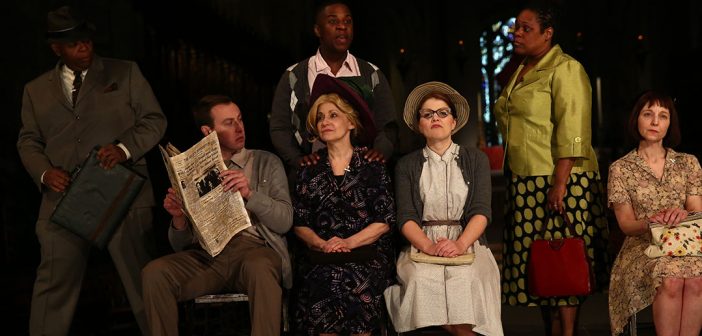In the 1950s in the South, a fictional black woman boards a bus with a child. She encounters a self-satisfied, middle-aged racist white woman, also traveling with her son, a supposedly liberal-minded fellow who actually harbors these same tendencies.
Suffice to say, this iconic short story, “Everything That Rises Must Converge,” penned by the writer Flannery O’Connor, does not end well.
On Saturday, Sept. 28, the story will be performed live at Fordham’s Rose Hill campus.
“Everything That Rises Must Converge: Race & Grace in Flannery O’Connor,” will pair an afternoon symposium with an evening performance of the 1964 story. The event is being hosted by Fordham’s Curran Center for American Catholic Studies, which in May 2018 was awarded a $450,000 grant from the Mary Flannery O’Connor Trust to support programming related to the author.
The day will begin with a panel discussion from 2 to 4 p.m. in Tognino Hall. The panel will be moderated by Curran Center associate director Angela Alaimo O’Donnell, Ph.D., and will feature Rufus Burnett, Ph.D., assistant professor of theology at Fordham; Mark Chapman, Ph.D., associate professor of African American Studies at Fordham; and Karin Coonrod, a lecturer in directing at Yale University.
The symposium will be followed by a performance of the story by international theater troupe Compagnia de’ Colombari directed by Karin Coonrod, to take place in Fordham Prep’s Leonard Theatre at 7 p.m. It will be followed by a conversation with the actors.
O’Connor and Race
O’Donnell, whose forthcoming book Radical Ambivalence: Race in Flannery O’Connor will be published next spring by Fordham University Press, said one of the reasons why this short story is so interesting is that O’Connor doesn’t paint race relations in black and white. Instead, she creates characters who have internal complexity and who act out of mixed motivations. Everyone behaves badly, the ending of the story is tragic, and no one escapes some measure of blame.
In the story, the white woman, who has insisted her son accompany her on the bus since it was integrated, says in her conversations with him that African Americans shouldn’t mix with whites. She nevertheless engages with the son of the black woman when they sit next to them, and when she offers the boy a penny, his mother reacts with deadly fury to the white woman’s condescension.
“I’ve been teaching the story for many years, and it’s gotten more and more challenging to discuss as the years have gone by, as we have a better sense of the tensions and dynamics that govern the relationships between African Americans and whites, both past and present,” she said.
The Myth of ‘White Innocence’
What’s complicated the task, she said, is the fact that while O’Connor possessed an ability—thanks to time spent living in the Northeast and the Midwest—to critique the white supremacy baked into the society in which she was raised, and excelled at writing about the relationship between African Americans and whites, she ultimately ascribes a quality of innocence to the benighted white woman in the story. The woman’s racism is not represented as a virulent force, based in violence and perpetuated by violence, but as a mistaken perspective.
In contrast to this, O’Donnell noted that during the same era O’Connor was writing her story, James Baldwin wrote that racial equality will only be achieved when the myth of “white innocence” is put to rest.
“That’s a concept that we in our time are getting a better handle on, but it’s not a perspective that O’Connor found compelling,” she said.
In fact, O’Donnell argues in her book that despite her best intentions, there are times when O’Connor subconsciously upholds some of the unjust racial practices of the South.
“It’s pretty clear that her sense was that the civil rights movement was very problematic, in part because of the insistence on the part of African Americans that desegregation take place immediately. For O’Connor, as for many white Southerners, the changes were happening too fast and threatened to undermine society. In addition, like most Catholics, O’Connor had a long view of history,” she said.
“[She felt that] you don’t change human nature and you don’t change society overnight by creating new laws. She thought it should be something that happens organically and slowly, and not all at once.”
The story is relevant in 2019, O’Donnell said, because it gives us an opportunity to understand how complex it was to live in that culture and in that time, to understand how fraught it was and how difficult it is for any society to change—a principle that applies to our own current cultural moment.
‘A Powerful Communal Experience’
O’Donnell attended a previous staged production of the story, which takes its dialogue verbatim from O’Connor’s pages. She said the transformation of a story read privately on the page to a drama performed publicly on the stage makes for a powerful communal experience.
“It’s a very interesting experience to witness this play, because as we are watching these characters sitting on the makeshift bus, fighting among themselves, we feel like we are on that bus, too, as it becomes a microcosm of America” she said.
“We are still fighting many of the same battles that we were fighting in 1964; they’re just no longer happening on the bus. They’re happening in other places.”
The event is free and open to the public, though registration is required. To register, visit the Curran Center’s event page.



